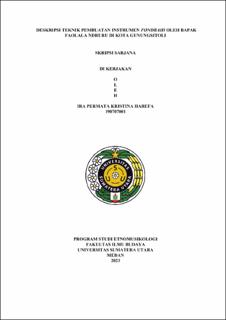Deskripsi Teknik Pembuatan Instrumen Fondrahi oleh Bapak Faolala Ndruru di Kota Gunungsitoli

Date
2023Author
Harefa, Ira Permata Kristina
Advisor(s)
Dewi, Heristina
Gulo, Hubari
Metadata
Show full item recordAbstract
This research discusses the techniques for making fondrahi instruments made by Mr. Faolala Ndruru, as well as describing the history of fondrahi instruments and techniques for playing fondrahi instruments. This instrument is one of the categories of religious musical instruments in the city of Gunungsitoli. Fondrahi is included in the membrane conical drum group because the shapes of the two side diameters are different sizes. The research aims to find out the techniques for making fondrahi instruments, find out their history, and explain the current development of fondrahi. This research method is qualitative with an ethnomusicological, field, and library research method approach. The theory used in this research refers to Khasima Shusumu's opinion that music studies can be divided into two, namely structural studies and functional studies. The results of this research show that first, the technique of making fondrahi instruments requires a long process and stages and requires patience and precision in making the details. The part that can produce sound is the goat's skin when it is hit. Historically, fondrahi is a religious instrument used in ancient Nias people's sacred ceremonies, such as death ceremonies, giving names to newborn babies, and for healing sick livestock. Fondrahi can only be hit by an ere while chanting a poem called hoho which contains prayers and requests to the ancestors. Until now, fondrahi is still used, but not for its function as a religious musical instrument, but has now turned into an entertainment musical instrument and has been collaborated with entertainment musical instruments at certain events.
Collections
- Undergraduate Theses [308]
